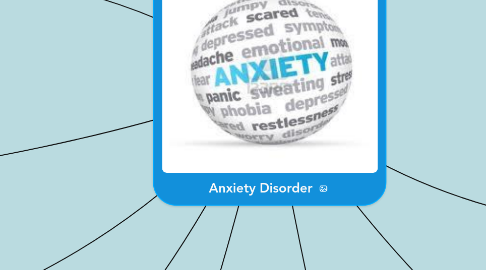
1. Pathophysiology
1.1. Hyperactivity of Amygdala
1.1.1. Medulla oblongata activates "fight or flight" response
1.1.1.1. Lungs
1.1.1.2. Cardiac Muscles
1.1.1.2.1. Body thinks extra air is needed
1.1.1.2.2. Body doesn’t actually need extra air to fight or flee
2. Risk Factors
2.1. Genetics
2.2. Female
2.3. Childhood trauma
2.4. Stress due to an illness
2.5. Drugs,alcohol, caffiene
3. Definition
3.1. Anxiety
3.1.1. Vague and uneasy feeling
3.1.2. Response to real or imagined stress
3.2. Anxiety Disorder
3.2.1. Significant distress
3.2.2. Worry and fear are constant and overwhelming
3.2.3. Crippling
3.2.4. Impairment to ADLS
3.3. Anxiety state
3.3.1. Coping abilities are overwhelmed
3.3.2. Emotional control is lost
3.4. Anxiety trait
3.4.1. Learned component
3.4.2. Reacts to relatively nonstressful situations with anxiety
4. Levels of Anxiety
4.1. Mild Anxiety
4.1.1. Few physical symptoms
4.1.2. Can improve motivation
4.1.3. Increases a persons ability to learn and focus, improving concentration
4.2. Moderate Anxiety
4.2.1. Vitals signs increased
4.2.2. Alert, focused, optimum state for problem solving
4.3. Severe Anxiety
4.3.1. Severe anxiety-fight or flight response
4.3.2. Vitals increased
4.3.3. Sweating
4.3.4. Muscles rigid tense
4.3.5. Person has a perception field that is narrowed
4.3.6. Problem solving difficult
4.3.7. Selective inattention
4.3.8. Distortion of time
4.3.9. Threatened, overloaded, need for space increased
5. Prevention
5.1. Reduce your risk and methods to control or lessen symptoms
5.1.1. Reducing caffeine, tea, cola, and chocolate consumption
5.1.2. Checking with a doctor or pharmacist before using over-the-counter or herbal remedies
5.1.3. Exercising regularly
5.1.4. Eating healthy foods
5.1.5. Keeping a regular sleep pattern
5.1.6. Seeking counseling and support
5.1.7. Avoiding alcohol, cannabis
6. Diagnosis
6.1. Diagnosed by mental health professional
6.1.1. Mental Health Assessment and Interview
6.1.2. Person's symptoms and degree of disability point to a diagnosis of a specific disorder
6.1.3. Complete physical examination to eliminate any possible underlying ailments
6.1.3.1. Anemia
6.1.3.2. Thyroid Issues
7. Nucleus Ambiguus
7.1. Increase blood
7.1.1. Arterioles Constrict
7.2. Oxygen
8. Alert Adrenal Medulla
8.1. Releases Adrenaline and Dopamine
8.1.1. Epinephrine
8.1.1.1. Increases Blood Pressure
8.1.1.2. Increases Glucose
9. Amygdala
10. Signs and Symptoms
10.1. Feelings of panic, fear, and uneasiness
10.2. Uncontrollable, obsessive thoughts
10.3. An inability to be still and calm
10.4. Dry mouth
10.5. Numbness or tingling in the hands or feet
10.6. Nausea
10.7. Muscle tension
10.8. Dizziness
10.9. Increase in vital signs
11. Treatment
11.1. Medication
11.1.1. Benzodiazepines
11.1.2. Serotonin reuptake inhibitors (SSRIs)
11.1.3. Tricyclic antidepressants (TCAs)
11.1.4. Monoamine oxidase inhibitors (MAOIs)
11.2. Psychotherapy
11.3. Cognitive-behavioral therapy
11.4. Dietary and lifestyle changes.
11.4.1. Eat a Balanced diet
11.4.2. 7-8 hours of sleep
11.5. Relaxation therapy
11.5.1. Meditate
11.5.2. Deep Breathing
12. Nursing Interventions
12.1. Biologic Domain
12.1.1. Teach breathing control
12.1.2. Maintain regular balanced eating patterns
12.1.3. Reduce intake of caffeine, stimulants
12.1.4. Encourage exercise
12.1.5. Administer medication, and monitor for side effects
12.2. Social Domain
12.2.1. Assist with lifestyle and relationships recalculation and restructuring
12.2.2. Assist with time management
12.2.3. Decrease lifestyle stress
12.2.4. Family Therapy
12.2.5. Support Groups
12.3. Psychological Domain
12.3.1. Stay with patient during acute attack
12.3.2. Perform behavioral analysis to identify triggers
12.3.3. Teach progressive muscle relaxation
12.3.4. Distraction techniques
12.3.5. Provide education to correct myths and mistinterpretations
12.4. Reduce fear and anxiety
12.4.1. Orient client to environment, equipment, and routines
12.4.2. Introduce client to staff-maintain consistency in staff
12.4.3. Assure client that staff members are nearby; respond to call signal as soon as possible
12.4.4. Maintain a calm, supportive, confident manner when interacting with client
12.4.5. Encourage verbalization of fear and anxiety; provide feedback
13. Complications
13.1. Lead to, or worsen, other mental and physical health conditions
13.1.1. Depression
13.1.2. Substance abuse
13.1.3. Insomnia
13.1.4. Digestive or bowel problems
13.1.5. Headaches
13.1.6. Teeth grinding
14. Coping Strategies
14.1. Write down your worries
14.2. Create an anxiety worry period
14.3. Accept uncertainty
14.4. Practice relaxation techniques
14.5. Adopt healthy eating habits
14.6. Reduce alcohol and nicotine
14.7. Exercise regularly
14.8. Learn to replace "negative self talk" with "coping self talk"
14.9. Get enough sleep
15. Myth &Conceptions
15.1. Snap a rubber band on your wrist every time you have a bad thought
15.1.1. Relality Check
15.1.1.1. The thoughts you resist persist.
15.2. If a panic attack gets too bad, you can pass out or lose control
15.2.1. Reality check
15.2.1.1. Fainting= blood pressure drop
15.2.1.2. During a panic attack=blood pressure increases
15.3. Avoid all stressful situations
15.3.1. Reality check
15.3.1.1. fragile and avoiding risk leads to feeling demoralized
15.3.1.2. Avoiding anxiety tends to reinforce it
15.4. Always carry a paper bag in case you hyperventilate
15.4.1. Reality check
15.4.1.1. Safety crutches that keep you anxious about being anxious
15.5. Medications for anxiety are addictive
15.5.1. Reality check
15.5.1.1. First-line medications for anxiety disorders (the SSRI and SNRI antidepressants) are not addictive
15.5.1.2. Benzodiazepines are used for short term
15.5.1.2.1. Increased tolerance and dependence after long-term use.
15.6. Medication is the only treatment for anxiety disorders.
15.6.1. Reality check
15.6.1.1. Cognitive-behavioral therapy may be just as or more effective than medication in the long term
15.7. Some people are just worrywarts or neurotic
15.7.1. Reality check
15.7.1.1. Therapy can help you reduce worry and suffering
